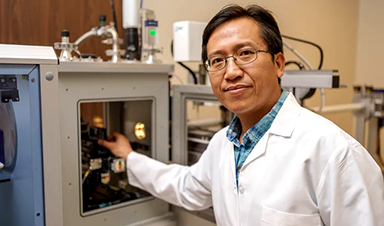Over 2.8 million Americans get antibiotic-resistant bacterial infections annually, and about 35,000 of those patients do not make it through their infection, according to the Centers for Disease Control and Prevention.
Hongjun (Henry) Liang, Ph.D., of the Texas Tech University Health Sciences Center (TTUHSC) Department of Cell Physiology and Molecular Biophysics, has largely focused his research on creating novel nanoparticles known as nanoantibiotics that address bacterial infections, particularly those that are resistant to treatment with commonly used antibiotics, to find solutions to the problem of antibiotic resistance.
As of July 26th, 2022, a US patent titled “Hydrophilic Nanostructured Membrane Active Antimicrobials With High Activity, Selectivity And Biodegradability” had been issued in connection with Liang’s work, enabling the Liang laboratory team to manufacture the innovative nanoantibiotics.
We have a lot of antibiotics already being used in the clinics, and many of them are quite effective to ordinary infections. But we are facing this increasing challenge with MRSA (methicillin-resistant staphylococcus aureus) and other kinds of drug-resistant bacteria, which are the bacteria that turns ordinary infections into life-threatening events.
Hongjun Liang, Department of Cell Physiology and Molecular Biophysics, Texas Tech University Health Sciences Center
The ability of a molecule to repel water (hydrophobicity) or to attract water and dissolve in it (hydrophilicity) has been shown to have a major impact on cells in previous studies. According to Liang, a material will have a higher negative effect the more hydrophobic it is.
He emphasized that there is, however, no quantitative benchmark for the acceptable level of hydrophobicity.
Liang added, “Basically, you can kill bacteria when you increase hydrophobicity. But it also will kill healthy cells, and we don’t want that.”
The Liang team created unique hydrophilic nanoantibiotics in a study published in January 2022 in Nature Communications. These nanoantibiotics had the appearance of tiny hairy spheres and were made of many hydrophilic polymer brushes grafted onto silica nanoparticles of various sizes.
These man-made substances, which are also produced by Liang’s lab, are intended to kill bacteria by disrupting their membranes by utilizing a distinct method of membrane remodeling that affects bacterial membranes while leaving mammalian cells unharmed.
This was the third paper on nanoantibiotics that the Liang lab has published. The first and second publications that described the hydrophilic nanoantibiotic design approach were released in 2017 by ACS Infectious Disease and in 2020 by Biomacromolecules.
Both were highlighted by Chemical & Engineering News and featured as cover stories in their respective journals.
Liang said his team is now concentrating on a two-pronged approach to enhance and improve the nanoantibiotics for use in patients, armed with the three published findings and the patent.
Pushing for clinical trials is the first strategy, which Liang defined as the research and academic component of his approach. The Liang lab will begin that procedure by submitting new applications for federal funding that support animal studies and ultimately result in clinical trials on human subjects.
He stated, “That is more like the research and academic side of our effort.”
Working with the Texas Tech University Innovation Hub to assist in the commercialization of Liang’s lab’s invention is the second element of his approach.
“By taking the training opportunity on research commercialization from our Innovation Hub, hopefully, we are able to identify interested parties in the pharmaceutical industry who are able or willing to collaborate with us. One of our likely directions is to apply for an SBIR (Small Business Innovation Research) grant to pilot scale production. That’s our two-pronged approach,” stated Liang.
Infection is a major concern for both scientists and practicing physicians, according to Liang. By harnessing innovation to develop a new generation of antibiotics, he hopes to be able to overcome this issue.
Liang concluded, “That is our goal and we are well on our way to that. I can’t say this is the only way forward; of course, there are many different ways. The novelty of our contribution is to tackle this challenge by designing antibiotics from a nanoengineering point of view. This is a very new path that is not well explored, and we are proud of our progress so far.”
News
New Once-a-Week Shot Promises Life-Changing Relief for Parkinson’s Patients
A once-a-week shot from Australian scientists could spare people with Parkinson’s the grind of taking pills several times a day. The tiny, biodegradable gel sits under the skin and releases steady doses of two [...]
Weekly injectable drug offers hope for Parkinson’s patients
A new weekly injectable drug could transform the lives of more than eight million people living with Parkinson's disease, potentially replacing the need for multiple daily tablets. Scientists from the University of South Australia [...]
Most Plastic in the Ocean Is Invisible—And Deadly
Nanoplastics—particles smaller than a human hair—can pass through cell walls and enter the food web. New research suggest 27 million metric tons of nanoplastics are spread across just the top layer of the North [...]
Repurposed drugs could calm the immune system’s response to nanomedicine
An international study led by researchers at the University of Colorado Anschutz Medical Campus has identified a promising strategy to enhance the safety of nanomedicines, advanced therapies often used in cancer and vaccine treatments, [...]
Nano-Enhanced Hydrogel Strategies for Cartilage Repair
A recent article in Engineering describes the development of a protein-based nanocomposite hydrogel designed to deliver two therapeutic agents—dexamethasone (Dex) and kartogenin (KGN)—to support cartilage repair. The hydrogel is engineered to modulate immune responses and promote [...]
New Cancer Drug Blocks Tumors Without Debilitating Side Effects
A new drug targets RAS-PI3Kα pathways without harmful side effects. It was developed using high-performance computing and AI. A new cancer drug candidate, developed through a collaboration between Lawrence Livermore National Laboratory (LLNL), BridgeBio Oncology [...]
Scientists Are Pretty Close to Replicating the First Thing That Ever Lived
For 400 million years, a leading hypothesis claims, Earth was an “RNA World,” meaning that life must’ve first replicated from RNA before the arrival of proteins and DNA. Unfortunately, scientists have failed to find [...]
Why ‘Peniaphobia’ Is Exploding Among Young People (And Why We Should Be Concerned)
An insidious illness is taking hold among a growing proportion of young people. Little known to the general public, peniaphobia—the fear of becoming poor—is gaining ground among teens and young adults. Discover the causes [...]
Team finds flawed data in recent study relevant to coronavirus antiviral development
The COVID pandemic illustrated how urgently we need antiviral medications capable of treating coronavirus infections. To aid this effort, researchers quickly homed in on part of SARS-CoV-2's molecular structure known as the NiRAN domain—an [...]
Drug-Coated Neural Implants Reduce Immune Rejection
Summary: A new study shows that coating neural prosthetic implants with the anti-inflammatory drug dexamethasone helps reduce the body’s immune response and scar tissue formation. This strategy enhances the long-term performance and stability of electrodes [...]
Scientists discover cancer-fighting bacteria that ‘soak up’ forever chemicals in the body
A family of healthy bacteria may help 'soak up' toxic forever chemicals in the body, warding off their cancerous effects. Forever chemicals, also known as PFAS (per- and polyfluoroalkyl substances), are toxic chemicals that [...]
Johns Hopkins Researchers Uncover a New Way To Kill Cancer Cells
A new study reveals that blocking ribosomal RNA production rewires cancer cell behavior and could help treat genetically unstable tumors. Researchers at the Johns Hopkins Kimmel Cancer Center and the Department of Radiation Oncology and Molecular [...]
AI matches doctors in mapping lung tumors for radiation therapy
In radiation therapy, precision can save lives. Oncologists must carefully map the size and location of a tumor before delivering high-dose radiation to destroy cancer cells while sparing healthy tissue. But this process, called [...]
Scientists Finally “See” Key Protein That Controls Inflammation
Researchers used advanced microscopy to uncover important protein structures. For the first time, two important protein structures in the human body are being visualized, thanks in part to cutting-edge technology at the University of [...]
AI tool detects 9 types of dementia from a single brain scan
Mayo Clinic researchers have developed a new artificial intelligence (AI) tool that helps clinicians identify brain activity patterns linked to nine types of dementia, including Alzheimer's disease, using a single, widely available scan—a transformative [...]
Is plastic packaging putting more than just food on your plate?
New research reveals that common food packaging and utensils can shed microscopic plastics into our food, prompting urgent calls for stricter testing and updated regulations to protect public health. Beyond microplastics: The analysis intentionally [...]





















